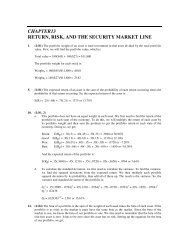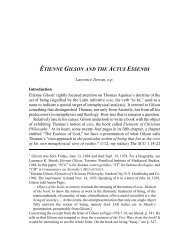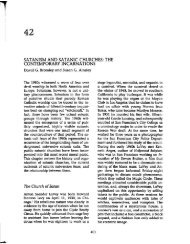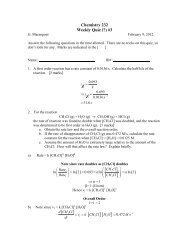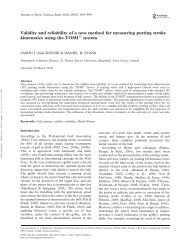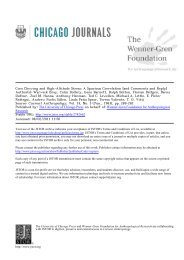Create successful ePaper yourself
Turn your PDF publications into a flip-book with our unique Google optimized e-Paper software.
J. Bmmechanics Vol. 25, No. 9, pp. 975-983. 1992.<br />
Printed in Great Britain<br />
<strong>THE</strong> <strong>ROLE</strong> <strong>OF</strong> <strong>THE</strong> <strong>SHAFT</strong> <strong>IN</strong> <strong>THE</strong> <strong>GOLF</strong> SW<strong>IN</strong>G<br />
RONALD D. MILNE* and JOHN P. DAVIS?<br />
Departments of *Engineering Mathematics and JCivil Engineering, University of Bristol,<br />
Bristol BS8 ITR, U.K.<br />
CQZl-9290/92 %S.oO+.OO<br />
Pergamon Press Ltd<br />
Abstract--Current marketing of golf clubs places great emphasis on the importance of the correct choice of<br />
shaft in relation to the golfer. The design of shafts is based on a body of received wisdom for which there<br />
appears to be little in the way of hard evidence, either of a theoretical or experimental nature. In this paper<br />
the behaviour of the shaft in the golf swing is investigated using a suitable dynamic computer simulation<br />
and by making direct strain gauge measurements on the shaft during actual golf swings. The conclusion is,<br />
contrary to popular belief, that shaft bending flexibility plays a minor dynamic role in the golf swing and<br />
that the conventional tests associated with shaft specification are peculiarly inappropriate to the swing<br />
dynamics; other tests are proposed. A concomitant conclusion is that it should be difficult for the golfer to<br />
actually identify shaft flexibility. It is found that if golfers are asked to hit golf balls with sets of clubs having<br />
different shafts but identical swingweights the success rate in identifying the shaft is surprisingly low.<br />
<strong>IN</strong>TRODUCTION<br />
‘We challenge anyone to prove the shaft is not the<br />
most important component of a golf club’. This bold<br />
statement accompanied a recent advertisement for<br />
golf clubs in a popular golf magazine and is typical of<br />
the emphasis that is currently being placed on the role<br />
of the shaft in golf club design. Shafts are currently<br />
being manufactured to closer tolerances than ever<br />
before and in a wider range. What is in doubt is the<br />
basis of the design philosophy. Roughly speaking, the<br />
received wisdom dictates that the more flexible shaft is<br />
better suited to the weaker player, while the profes-<br />
sional or good amateur should use a stiffer shaft.<br />
Considered as an empirical result arising from the<br />
long development of golf, it must be taken seriously;<br />
however, within the context of the dynamics of the<br />
golf swing, it is not an obvious conclusion. A typical<br />
explanation (Tolhurst, 1989) of the effect of shaft<br />
flexibility runs along the following lines (for those<br />
unfamiliar with golf, a glossary of terms is given in<br />
Appendix 1). The shaft is initially bent backwards in<br />
the early part of the downswing and then recovers just<br />
before impact. If the shaft is too flexible for the golfer,<br />
it springs forward too far, thereby increasing the<br />
effective loft and closing the clubface; if too stiff, it is<br />
still bent backwards, the loft is decreased and the face<br />
is open. In this sense the shaft should be matched to<br />
the golfer’s swing speed and hand action. Claims are<br />
sometimes made for increased clubhead speed at im-<br />
pact, assuming that the golfer’s timing can utilise the<br />
springing back of the shaft. The link between change<br />
in loft and closing or opening of the clubface is due to<br />
the clubhead being attached to the shaft at the lie<br />
angle (Appendix 1). The actual extent to which the loft<br />
is changed by shaft bending can be controlled by the<br />
location of the so-called kick-point which relates to<br />
the shape of the bent shaft at impact; a shaft with a<br />
Receiued in final form 8 January 1992.<br />
915<br />
low kick-point shows greater curvature near the tip<br />
region than one with a high kick-point.<br />
Shaft design is currently verified by three basic tests.<br />
In the first the shaft is clamped at its butt over a<br />
standard length and then loaded transversely by a<br />
weight near the tip; the tip deflection yields a measure<br />
of the shaft bending stiffness, and the location of the<br />
maximum deviation of a chord joining the butt and<br />
tip from the deflection curve yields the kick-point. The<br />
second test measures the tip rotation due to an<br />
applied tip torque, so yielding the torsional stiffness.<br />
The third test measures the fundamental transverse-<br />
vibration frequency of the clamped shaft carrying a tip<br />
mass equivalent to a clubhead.<br />
The purpose of this study was to gain an under-<br />
standing of the flexing behaviour of the shaft during<br />
the swing by constructing a suitable dynamic model<br />
and to test the validity of the model experimentally.<br />
Shaft flex may affect the feel of a golf club during the<br />
swing; this difficult area warrants a full investigation<br />
on its own but results of a rather limited study are<br />
reported here since they add some weight to the<br />
conclusions.<br />
Computer simulation<br />
METHODS<br />
Flexibility of the shaft is manifest in bending and<br />
twisting. The former is the subject of careful design, so<br />
that desired characteristics are obtained, whereas the<br />
latter is seen as a necessary evil, which must be<br />
minimised. In this study emphasis is on bending flex-<br />
ibility; consequently, the dynamic model is a develop-<br />
ment of the well-established plane two-link model of<br />
the golf swing (Budney and Bellow, 1979; Daish,<br />
1972). This consists of an arm link driven by a shoulder<br />
torque and a club link driven by a wrist torque; the new<br />
element added to the established model is the bending<br />
flexibility of the club link. Although the bodily mo-<br />
tions of a golfer are quite complicated, numerous
916 R. D. MILNE and J. P. DAVIS<br />
photographic and kinematic studies have shown that<br />
the downswing is, indeed, executed more or less in a<br />
plane. One aspect of the real three-dimensional swing,<br />
which is imported into the essentially two-dimen-<br />
sional or plane model, derives from the fact that the<br />
centre of mass of the clubhead does not lie on the<br />
shaft. Due to the large centrifugal forces involved in<br />
the swing, this has an important effect on shaft bend-<br />
ing and, consequently, for this reason, it is necessary<br />
to allow for rotation of the clubhead in the plane of<br />
the swing, although this rotation has no direct effect<br />
on the momentum balances or impact mechanics in<br />
the plane. A description of the full equations of mo-<br />
tion together with details of the computation are set<br />
out in Appendix 2.<br />
One integral feature of the model is crucial and<br />
needs emphasis. The shaft has a bending stiffness,<br />
which is measured in the standard cantilever bending<br />
test already referred to. However, during the swing,<br />
particularly near impact when the centrifugal forces<br />
are large, the shaft also acquires an additional bend-<br />
ing stiffness due to the fact that the shaft is under<br />
considerable tension. In a full drive or similar-<br />
distance shot this bending stiffness due to tension is, in<br />
the 40 ms or so before impact, large enough to be<br />
comparable to the conventional bending stiffness.<br />
Strain gauge measurements<br />
Three golfers, labelled A, B and C, with handicaps<br />
of 11, 5 and 2, respectively, were used in these<br />
experiments; golfers B and C showed a high degree of<br />
consistency in repeating their swings. The club used<br />
for the tests was a metal driver with R shaft and<br />
having 10.5” of loft. Groups of foil strain gauges<br />
(Showa, 2 mm) were bonded to the shaft at three<br />
stations to measure two bending moments at each<br />
station, parallel and normal to the clubface. Tension<br />
and torque were also measured at one station. The<br />
gauges were calibrated directly for these moments and<br />
forces by appropriate static loadings of the shaft. The<br />
strain gauge amplifiers (Fylde mini-bal and mini-amp<br />
systems) transmitted data via an analogue/digital con-<br />
vertor (Barr-Brown PCI-20089) directly onto a com-<br />
puter (Toshiba 3100SX) controlled by data acquisi-<br />
tion software (Labtech Notebook); data was stored in<br />
a form suitable for subsequent analysis using the<br />
spreadsheet Lotus l-2-3. The typical run extended<br />
over 10 s beginning at address and ending at follow-<br />
through. Sampling was at the rate of 200 readings per<br />
second; at this sampling rate it was not possible to<br />
read all the gauges simultaneously and successive<br />
swings were used. Graphical displays of data could be<br />
obtained on the Toshiba screen immediately after a<br />
run in order to check for failure or inconsistency.<br />
Initial analysis located the region of interest from just<br />
before top of swing to shortly after impact by refer-<br />
ence to the obvious point of impact with the ball. The<br />
swing was also observed by a single high-speed video<br />
system running at a rate of 200 frames per second and<br />
shutter speed of l/10,000 of a second placed facing the<br />
golfer; the video system was an NAC Model HSV400<br />
with associated X Y-coordinator Model V-78-E<br />
coupled to an IBM-compatible PC using the motion<br />
analysis package MOVIAS (version 3). A video re-<br />
cording was also made along the line-of-flight direc-<br />
tion to establish the angle of the golfer’s swing plane.<br />
The video recordings allowed the gauge data to be<br />
correlated with swing position through the common<br />
time of impact and also allowed the construction of<br />
stick diagrams for the swing and the estimation of<br />
clubhead velocity and acceleration. The most import-<br />
ant information obtained from the recordings gave<br />
the orientation of the clubhead relative to the plane of<br />
the swing. This was needed to transform the parallel-<br />
to-clubface and normal-to-clubface bending-moment<br />
components to in-swing-plane and out-of-swing<br />
plane components since only the in-swing-plane com-<br />
ponents are relevant to the simulation. This aspect of<br />
the experimental method was the least satisfactory.<br />
The clubface was marked and the video image was<br />
clear; nevertheless, an accurate measurement of the<br />
orientation was difficult. Typically, the clubhead<br />
rotates little during the downswing until within about<br />
50 ms of impact when it rotates through approx-<br />
imately a right-angle to square the clubface at impact.<br />
A simple smoothing routine was used to obtain both<br />
in-plane and out-of-plane bending moments. Out-of-<br />
plane bending moments were very small except near<br />
impact, where the values were consistent with out-of-<br />
plane bending of the shaft due to centre-of-mass offset:<br />
the behaviour of the resolved bending moments serves<br />
to give confidence in the plane-swing model. Were<br />
experiments of this type to be repeated, a more accur-<br />
ate and automatic way of measuring orientation,<br />
perhaps using laser marker techniques, would be<br />
advisable. Questions of cost precluded such an ap-<br />
proach in these experiments.<br />
RESULTS<br />
A set of results is shown in full for golfer B only;<br />
results for golfers A and C naturally differ in detail but<br />
not enough to alter the overall picture as far as the<br />
shaft behaviour is concerned. A typical set of results<br />
for a swing simulation is shown in Fig. 1. Clubhead<br />
speed at impact estimated from the video via the<br />
MOVIAS program was 41.4 ms-‘. The initiation<br />
time for the swing simulation was chosen as 400 ms<br />
before impact, at which point in the backswing the<br />
shaft is straight and the wrist torque is just beginning<br />
to reverse: angular velocities at initiation were estim-<br />
ated from the video recording. The diagrams have<br />
been extracted from a continuous screen display to<br />
illustrate the main features. The club used for the<br />
simulation is a driver; a long iron club would show a<br />
very similar swing except that the bending forward of<br />
the shaft before impact would be much reduced. The<br />
stick diagrams in Fig. 1 show the shaft deflection to<br />
scale, and it is difficult to perceive detail; so, the shaft
Time before impact 68 ms Time before impact 39ms<br />
Time before impilct l9ms<br />
Time after impact IOms Time after impact 24ms<br />
Role of shaft 911<br />
Sha ft.c+fkct+n<br />
wn’f’ed ’ bmes<br />
Driver-Iaft 10.5&9 lnyuct &city 41.6mIs Drier-loft Kl.5dcp Imct velocity Ll.Cm/s<br />
Clubface aqk ll.Bdq Ball vebcity 5X6m/s Ctubfact aqk 11.8de9 Ball velocity 5Z6m/s<br />
deflection is also shown magnified five times. These<br />
bending shapes are plotted in such a way that they<br />
have the property of being orthogonal (with respect to<br />
the club mass distribution) to a rigid-body rotation<br />
about the wrist hinge (Appendix 2). Other outputs<br />
from the simulation, shown in Fig. 2, are clubhead<br />
speed, clubhead deflection measured relative to a tan-<br />
gent at the butt end and hand force. The hand force is<br />
the internal vector force at the wrist hinge acting in<br />
opposite directions on the arm and club links; in<br />
Fig. 2 the components of this force are shown resolved<br />
along and normal to the instantaneous directions of<br />
both arm and club links. Figure 2 also shows the<br />
tension measured in the shaft at its mid-point: meas-<br />
ured mid-point torque is not shown, as it did not<br />
exceed 0.5 Nm until impact. In Fig. 3 are shown the<br />
simulated and measured in-swing-plane bending mo-<br />
ments at three stations along the shaft-at 10% (top),<br />
Fig. 1. Swing simulation showing shaft deflection.<br />
r-i!-<br />
1<br />
50% (middle) and 90% (bottom) of shaft length from<br />
the wrist hinge.<br />
Shoulder and wrist torques for the simulation ap-<br />
propriate to golfer B were synthesised from the strain<br />
gauge data in the following way. The shoulder torque<br />
can be estimated from the measured shaft tension by<br />
utilising the fact that the force exerted on the shaft by<br />
the hands is almost wholly axial to the shaft through-<br />
out the swing, the tangential component of the hand<br />
force being at most about 10% of the total; hence,<br />
shaft tension is little different from the total hand<br />
force, a result which can readily be demonstrated<br />
theoretically. By using a point in the swing at which<br />
the angular acceleration of the arm link is zero (about<br />
70 ms before impact) the inertia of the arms/torso is<br />
eliminated from the estimate. The agreement between<br />
axial (club) hand force and mid-shaft tension (Fig. 2) is<br />
very satisfactory when it is noted that the tension at
978 R. D. MILNE and J. P. DAVIS<br />
tim ms time ms<br />
- Axial<br />
---- Kangenttil<br />
‘-‘- shaft tension<br />
Fig. 2. Swing simulation outputs and measured mid-shaft<br />
tension.<br />
10. ______- ----__ ___<br />
--._<br />
g-1: 1 -f----- % t<br />
-10<br />
\_I--<br />
0 100 ZW 300 100 SW<br />
Time ins<br />
Fig. 3. Simulated and measured shaft bending moments.<br />
mid-shaft is approximately 90% of the tension at the<br />
top. The wrist torque can obviously be estimated from<br />
the measured bending moment at the top station; the<br />
nearer this station is to the wrist hinge the more<br />
accurate the estimate. Based on this evidence the<br />
shoulder torque was applied as a ramp function with<br />
rise time 110 ms and maximum amplitude 83 N m and<br />
the wrist torque was applied as a ramp function with<br />
rise time 275 ms and maximum amplitude 25 Nm.<br />
These simplified torques were not intended to match<br />
the golfer’s inputs exactly. The inputs for golfers A<br />
and C were qualitatively similar to those for golfer B<br />
and the level of agreement between simulation and<br />
measurement much the same; golfer C was a very long<br />
hitter generating a clubhead speed of 48 m s-l.<br />
<strong>IN</strong>TERPRETATION <strong>OF</strong> RESULTS<br />
For the purpose of describing the shaft behaviour<br />
the swing may be divided into three phases. In the first<br />
phase, which extends from about 230 ms before im-<br />
pact (top of the swing) to about 130 ms before impact,<br />
the application of the wrist torque bends the shaft<br />
backwards, the maximum deflection occurring near<br />
the end of this phase. In the second phase, which<br />
consists of the last 130 ms or so to impact, an unfold-<br />
ing of the system due to momentum transfer takes<br />
place. The shaft behaves in a quasi-steady manner,<br />
gradually straightening and then bending forward due<br />
to the anticlockwise centrifugal torque applied at the<br />
lower end of the shaft by the offset of the centre of<br />
mass of the clubhead behind the shaft centre-line. This<br />
torque is closely represented by the bending moment<br />
at the bottom station (Fig. 3); near impact the effective<br />
clubhead weight is some 150 times its actual weight,<br />
so the magnitude of the torque applied is some 3 N m<br />
for each centimetre of centre-of-mass offset. The main<br />
effect is to give the club an additional dynamic loft at<br />
impact with a corresponding closing of the clubface.<br />
The nett clubface angle at impact with the ball is<br />
recorded by the simulation (Fig. 1). It is important to<br />
note that the position of the centre of mass of the<br />
clubhead relative to the hands is along the local<br />
centrifugal vector, so that if the shaft is bent forward<br />
then the club butt-to-arm angle is correspondingly<br />
increased and vice versa (see also Fig. 4). In phase<br />
three the effect of impact on the shaft is to excite a few<br />
cycles of bending vibration at a frequency of about<br />
30 Hz. Some of the energy at impact is spent in<br />
exciting the shaft; for example, given the same set of<br />
input torques, the simulation shows that a flexible<br />
shaft produces an initial ball velocity which is about<br />
4% lower than that produced by an equivalent ideal-<br />
ised ‘rigid’ shaft.<br />
The computer simulation necessarily incorporates<br />
a model of the dynamic characteristic or impedance of<br />
the wrist joint, and this is an area where information is<br />
lacking: experimental work such as that carried out by<br />
Brown et al. (1982) on other human joints is badly<br />
needed. When gripped by a golfer, the club is very far<br />
from being clamped, as in the standard bending and<br />
vibration tests. The stiffness or the in-phase compon-<br />
ent of the wrist impedance torque is probably quite<br />
small when, near impact, the joint is relaxed and<br />
rapidly developing. The damping or the out-of-phase<br />
component is large enough near impact to actually<br />
apply a retarding torque. The measured top station<br />
bending moment in Fig. 3 clearly shows the decrease<br />
of the wrist torque approaching impact as the rota-<br />
tion speed of the joint rapidly increases. This behavi-<br />
our was observed for all the golfers tested and has<br />
been observed by others (Budney and Bellow, 1979);<br />
details of the impedance used in the model are given in<br />
Appendix 2. By varying the impedance-damping level<br />
and using the same demand inputs, the simulator can<br />
arrive at impact with wrist torques which vary from<br />
decelerating (the usual case.) through neutral to accel-<br />
erating. The results from three simulations of this<br />
type, based on the swing of golfer B but taken over a<br />
rather extreme range for emphasis, are shown in<br />
Fig. 4. Note that the clubface angle at impact is the
-_<br />
Role of shaft 979<br />
r<br />
SWI defkction<br />
1982; Cochran and Stobbs, 1969) and confirm an<br />
maaniti& 5 times<br />
lime betore impact 4 ms<br />
earlier description of shaft behaviour which was based<br />
lIecekr&g wrist torque<br />
solely on well-founded physical reasoning (Williams,<br />
at inplct I- mNml<br />
1969).<br />
!<br />
DISCUSSION<br />
The main aim of the work reported here was to<br />
elucidate, in a qualitative way, the dynamic flexing<br />
1, -5 0 cm<br />
behaviour of the golf shaft during the swing. In the<br />
Drim-loft m.5* Impct vrbcityQ.9m/s<br />
simulation the precise torques generated by the<br />
Clubface u?pk B8dcg Bali nkcity 566 m/s<br />
‘golfer’ are open to question but the inertial and<br />
he before itquct 3ms<br />
MC&a/ wrist ivrque<br />
at impact (0 Nm)<br />
1,<br />
imposed forces and torques applied to the shaft itself,<br />
L-r<br />
as verified by the strain gauge measurements, are<br />
undoubtedly typical of the golf swing and, hence, the<br />
level of confidence that may be placed in the simulator<br />
is high. The simulator could be used as a design tool<br />
to explore in detail the interaction between a range of<br />
shafts and ‘golfers’ as represented by their input<br />
torques. No attempt is made to do this here, but it is<br />
worth remarking that widely different shoulder<br />
-5 0 cm 5 torques lead to similar simulated swings provided the<br />
Driver-loft 10.5dq Impct v&city 122m/s<br />
same amount of work is done: this is not a surprising<br />
Ctubfaa an9k 12&q Ball nlocity 58.4 m/s<br />
result if one remembers that the swing is the outcome<br />
Time be/on impact 2ms<br />
of a double time integration and is reflected in the<br />
observation that, on the golf course, very different<br />
looking golf swings can produce similar results.<br />
The burden of the conclusions arising from the<br />
study is that shaft flexibility does not play an important<br />
dynamic role in the swing and the principal effect<br />
&her-btt M5de9 1-t bvtocity 43.5m/s<br />
of flexibility, namely, change in the effective loft at<br />
impact, could be estimated from static considerations.<br />
A simple test which would serve this purpose is illustrated<br />
in Fig. 5(a); this simulates the behaviour of the<br />
shaft of a wooden club just before impact when condi-<br />
Cl&face qle 13.Ldq BaX v&city 60 1 m/s<br />
tions are quasi-steady and the shaft is subject to a<br />
Fig. 4. Effect of wrist torque on shaft shape at impact. large axial load. The outcome of the test is a direct<br />
measure of the change in the effective loft (per unit<br />
centre-of-headmass offset) which this shaft would give<br />
result of two opposing effects, the change in butt-to-<br />
arm angle. being counteracted by the change in rota-<br />
tion at the shaft tip. The impact velocity is increased<br />
only by 2.6 m s- ‘, which is consistent with the fact<br />
that, for the whole swing to impact, approximately<br />
92% of the work done comes from the shoulder<br />
torque (via the torso and legs) and only 8% from the<br />
wrist torque.<br />
The clamped bending frequency of a driver is typi-<br />
cally of the order of 4.5 Hz, whereas the bending<br />
frequency observed for a club freely hinged near its<br />
butt end as illustrated in Fig. 5(b) is of the order of<br />
25 Hz. The bending frequency for a club, freely rota-<br />
ting about a hinge near its butt end and having a<br />
speed of rotation which gives the head a speed of<br />
40 m s- I, is about 32 Hz as observed in the simulation<br />
after impact; in this situation the frequency is only<br />
weakly dependent on the shaft bending stiffness. The<br />
three phases described above are all observable in<br />
high-speed photographs of golfers’ swings (Maltby,<br />
(b) m<br />
Changeotlottdwtooftaotofcmtmof<br />
- cd clubhud lrom sh#t cantm IIM<br />
ShCftICplVOtCdCtbldtCndlOCdWIC<br />
rppScd vlc rigId bm&ct ct lip<br />
Appllcalon 01 wlcl torque un bc<br />
*mummd by applybIg mothnr load via<br />
� rtgld bmcket atUch#d at butt<br />
Lcwca ncxuml Vlbmtlon mode 01 Divomd<br />
ShM with bndrmu<br />
Fig. 5. Proposed shaft tests.
980<br />
and is related to the player’s clubhead speed at impact<br />
if the load W is given a value appropriate to the<br />
centrifugal force on the head; it automatically takes<br />
account of the change in club butt-to-arm angle al-<br />
ready referred to earlier. Application of a torque at the<br />
butt end can simulate the golfer’s wrist torque at<br />
impact. This test is reflected in the common practice<br />
amongst golfers of resting the toe of a club on the<br />
ground and then pushing the butt firmly downwards!<br />
Clearly, another test which should be included in<br />
shaft testing is the measurement of the fundamental<br />
bending-vibration frequency of a shaft-plus-head sus-<br />
pended freely from a pivot as illustrated in Fig. 5(b).<br />
To demonstrate the effect of an increase in the bend-<br />
ing stiffness due to centrifugal force, approximate<br />
vibration frequencies are shown for a rotating shaft-<br />
plus-head and for a rotating chain-plus-head, the<br />
chain having the same mass distribution as the shaft<br />
but, of course, zero conventional bending stiffness.<br />
If shaft flexibility is not dynamically significant then<br />
why is it apparently so important to the golfer? To<br />
begin to answer this question in a very preliminary<br />
way a series of trials was conducted with a small<br />
group of golfers consisting of four amateurs, with<br />
handicaps ranging from 13 to 5, and four profes-<br />
sionals. Three sets of clubs were specially prepared,<br />
each set having identical swing weights but fitted with<br />
R, S and X shafts, two sets of five-irons (with solid<br />
back and peripherally weighted heads) and a set of<br />
drivers. The decals on the shafts were covered by a<br />
code letter and the participants were instructed not to<br />
bend the shaft or to waggle the club but simply to hit<br />
golf balls. The results were somewhat surprising. The<br />
amateurs were unable to distinguish one shaft from<br />
another either for woods or irons; typically, if pressed<br />
as to which shafts they preferred, they would chose the<br />
R and X over the S or, if asked for an order of<br />
flexibility, would give an almost random selection.<br />
Striking of the ball did not seem to be greatly affected,<br />
although no measurements were made of ball traject-<br />
ory. The professionals were not much better at dis-<br />
criminating between the irons but were quite success-<br />
ful with the woods. However, even here success was<br />
not complete, although the R shaft could generally be<br />
distinguished from the S and X shafts. These very<br />
simple and restricted tests do suggest that more exten-<br />
sive and significant work should be undertaken in this<br />
area. Recently, Pelz (1990) has conducted ‘blind’ golfer<br />
trials to compare the performance of steel and graph-<br />
ite shafts of differing flexibilities and Van Gheluwe et<br />
al. (1990) have shown that the kinematics of a golfer’s<br />
swing appears to be independent of the shaft material.<br />
CONCLUSIONS<br />
Do the results of this study bear out the accepted<br />
explanation of the effect of shaft flexibility given in the<br />
Introduction? The study confirms that flexibility will<br />
produce a change of loft (and close clubface) at im-<br />
pact but shows that these are really quasi-static effects<br />
R. D. MILNE and J. P. DAVIS<br />
and not dependent on a dynamic ‘springing back’ of<br />
the shaft from its bent position at the start of the<br />
swing. It is difficult to give any credence to the sugges-<br />
tion that the shaft can actually be bent backwards at<br />
impact and no photographic evidence exists to sup-<br />
port this contention. Kick-point should be replaced<br />
by a measure of shaft-tip rotation due to an offset<br />
axial load. Nor does springing back or ‘whipping’ of<br />
the shaft play a dynamic role in the all-important pre-<br />
impact area, although the ‘feel’ of the violent flexing of<br />
the shaft after impact may give the golfer the impres-<br />
sion that it does. Indeed, clubhead speed at impact is<br />
virtually unchanged if, using the simulator, the shaft is<br />
replaced by a heavy chain about 60 ms before impact.<br />
Perhaps the major source of misunderstanding about<br />
the role of the shaft is associated with the idea that the<br />
club is ‘gripped’ by the golfer, resembling the condi-<br />
tion of the built-in butt end of the cantilever test,<br />
combined with a lack of appreciation of the magni-<br />
tude and speed of response of any forces and moments<br />
applied by the player, which could significantly affect<br />
the course of the swing in the pre-impact area.<br />
The implications of this study for club design are<br />
somewhat problematical. It does appear that it may<br />
not be necessary to provide a range of shafts for iron<br />
clubs and possibly not even for wooden clubs. It is<br />
possible to argue that the ‘feel’ imparted to a club<br />
through shaft flexibility may actually affect the torque<br />
inputs of the player but the golfer tests gave no<br />
indication of this: there is room here for further study.<br />
If one takes the view that shaft flexibility is not of<br />
importance dynamically, it then represents an un-<br />
wanted swing variable and one is led to adopt a stiff<br />
shaft, a conclusion also reached by Pelz (1990). The<br />
effective loft that a golfer may have enjoyed with a<br />
fiexible shaft could then be reinstated (without the<br />
associated change in clubface angle) by an appropri-<br />
ate adjustment of nominal club loft. Do current stiff<br />
shafts represent an upper limit or could stiffer shafts<br />
be used? If the latter, then it would be possible to use a<br />
light, thin-walled shaft tapering to about twice the tip<br />
diameter of the currently available shafts coupled with<br />
a return to hosel-in-shaft fabrication; such a shaft<br />
would have considerably higher torsional stiffness<br />
than the currently available shafts.<br />
Finally, the point should be made that the fixity<br />
conditions of a shaft held in a golf machine are very<br />
different from those for a golfer and, therefore, the<br />
shaft performance data derived from this source do<br />
not necessarily apply to the ‘real’ golf swing.<br />
Acknowledgements-The authors would like to express their<br />
gratitude to Dunlop Slazenger International Ltd for finan-<br />
cial aid and for supplying golf clubs.<br />
REFERENCES<br />
Brown, T. I, H., Rack, P. M. H. and Ross, H. F. (1982) Forces<br />
generated at the thumb interphalangeal joint during im-<br />
posed sinusoidal movements. .I. Physici. 332, 69-85.<br />
Budney, D. R. and Bellow, D. G. (1979) Kinetic analysis of a<br />
golf swing. Res. Quart. Exercise Sport 50, 171-179.
Cochran, A. and Stobbs, J. (1969) The Search for the Perfect<br />
Swing. Heinemann, London, England.<br />
Daish, C. B. (1972) The Physics of Ball Games-Part II.<br />
English Universities Press, London, England.<br />
Maltby, R. (1982) Golf Club Design, Fitting, Alteration and<br />
Repair. Ralph Maltby Enterprises, Newark, NJ.<br />
Pelz, D. (1990) A simple scientific shaft test: steel versus<br />
graphite. In Proceedings of the First World Scientific Con-<br />
gress of Golf (Edited by Cochran, A. J.), pp. 264269.<br />
Chapman & Hall, London, England.<br />
Tolhurst, D. (1989) What you need to know before you buy.<br />
Golf Monthly Equipment Supplement, April 1989 issue.<br />
Van Gheluwe, B., Deporte, K. and Ballegeer, K. (1990) The<br />
influence of the use of graphite shafts on golf performance<br />
and swing kinematics. In Proceedings of the First World<br />
Scientific Congress of Golf (Edited by Cochran, A. J.), pp.<br />
258-263. Chapman & Hill, London, England.<br />
Williams, D. (1969) The Science of the Golf Swing. Pelham<br />
Books, London, England.<br />
APPENDIX 1<br />
GLOSSARY <strong>OF</strong> <strong>GOLF</strong><strong>IN</strong>G TERMS<br />
The golf club consists of three parts: the head, the shaft and<br />
the grip. The head is either a fairly narrow metal blade (iron)<br />
or a more extended, bulbous shape with a flattish front face<br />
(wood) made traditionally of wood but now also made in<br />
metal. The loft of the club is the angle which the front face of<br />
the head (clubface) makes with the vertical. The shaft is<br />
attached to the head by the hose1 or neck, which is a cylindri-<br />
cal extension of the head situated near one end of the<br />
clubface. The hose1 is angled to the head in such a way that<br />
when the base of the head is resting flat on the ground the<br />
shaft is at an angle to the horizontal called the lie angle. The<br />
centre of mass of an iron club is situated about halfway along<br />
the blade while the centre of mass of a wooden club is offset<br />
from the neck roughly along a line at 45” to the clubface. The<br />
shaft is either a steel tube or a solid composite tapering down<br />
from the grip end (butt) to the tip. The distribution of the<br />
taper controls the bending and torsional properties of the<br />
shaft. Shafts are commonly manufactured in three main<br />
categories R (regular), S (stiff) and X (extra stiff): within each<br />
category different weights and kick-point positions are<br />
offered. Typically, the ratio of clamped transverse vibration<br />
frequencies for R, S and X shafts is 1.00: 1.04: 1.08. The grip is<br />
simply a rubber tube which is glued to the butt of the shaft.<br />
At impact the clubface is said to be open ifit is pointing to<br />
the right of the target line and closed if it is pointing to the<br />
left: the efictioe lof is the actual angle of the clubface to the<br />
vertical at impact as opposed to the nominal loft of the club.<br />
Bending of the shaft in the swing plane near impact not only<br />
changes the loft but also opens or closes the clubface; for<br />
example, for a driver with lie angle of 55” the clubface will<br />
open (close) by an angle which is 70% of the change in the<br />
loft.<br />
The swing plane is the imaginary plane in which the player<br />
swings the clubhead and will generally be inclined somewhat<br />
steeper than the lie angle of the club.<br />
Due to the arrangement of bones and joints in the lower<br />
arms and wrists, the golfer is forced to roll or rotate his<br />
hands during the golf swing if he is to allow the wrist hinge to<br />
move freely: the face of the club lies roughly parallel to the<br />
swing plane at the top of the swing and is then rotated so as<br />
to be at right-angles to the swing plane at impact.<br />
APPENDIX 2<br />
<strong>THE</strong> MA<strong>THE</strong>MATICAL MODEL<br />
Equations of motion<br />
Figure Al illustrates the applied torques and rotation<br />
angles for the dynamic model. The relevant equations of<br />
Role of shaft 981<br />
Fig. Al. Applied torques and rotation<br />
dynamic model.<br />
angles for the<br />
motion, listed in the following, consist of<br />
(a) equations (1) and (2) representing the rate of change of<br />
angular momentum (including terms due to shaft flexibility)<br />
about the upper (fixed) pivot and about the wrist hinge,<br />
respectively, and<br />
(b) a variational equation (principle of virtual workj for<br />
shaft bending based on the small-deflection theory for slen-<br />
der beams including the effect on bending of tension in the<br />
shaft due to centrifugal forces. This integro-differential equa-<br />
tion is replaced by a number of ordinary differential equa-<br />
tions in time by representing the shaft bending displacement<br />
as a series of shape functions with time-dependent ampli-<br />
tudes (the Galerkin method) leading to equations (3), ,<br />
(n+2).<br />
Equation (1):<br />
(I,+m,l~)ti+ m,l,7,cos(+B)<br />
(<br />
-(i, EiCi+C)sinCO-B))$<br />
+ i E,cos(~-0)-<br />
i=1<br />
-(m.l,,csin(4-8)+<br />
-2 i E,&sin(4-0)$<br />
i=1<br />
+gsin0(l,m,+m,L)+ T,- T,=O,<br />
Equation (2):<br />
m,l,l;cos(#-0)-<br />
+(~, E,c,+c)cos))+T,rO.<br />
Equations (Z+i), i=l, . . . , n<br />
E,(sin(&e@+cos(4-e)i)+ i k,(T,+&)<br />
,=1<br />
+(cos(4-0)@-sin(+e)l) i; G,,rj+H,C<br />
j=l
982 R. D. MILNE and J. P. DAVIS<br />
- T,s;(o)/l,=o,<br />
G,,=f s ’ Ca(u)+mbls;(u)s;(u)du,<br />
+y,<br />
s 0<br />
* i<br />
s<br />
M,,=Pok P,(~W~,W du+wi(lb,W,<br />
0<br />
s<br />
1<br />
K,‘= [rk,(u)+m&;(u)s;(u)du, c=l,m,E,<br />
0<br />
ei(u)s;(u)s;(u)du,<br />
T,=Tt+imp@-4, e-4);<br />
dot denotes differentiation with respect to time, t,<br />
whereas prime denotes differentiation with respect to a,<br />
Z( 4) = distance of c of m of clubhead from shaft in<br />
swing plane,<br />
ei(u) = bending stiffness ratio of shaft, ei(0) = 1,<br />
EI = reference bending stiffness of shaft (at u = 0),<br />
&j=gcos(swp)<br />
(J = gravitational acceleration,<br />
{ swp = angle of swing plane to vertical,<br />
Jr = moment of inertia of arms/torso about upper<br />
pivot,<br />
I, = moment of inertia of club about wrist pivot,<br />
imp( ) = wrist impedance function,<br />
I, =length of arm link,<br />
1, = length of club link,<br />
L = distance of c of m of arm link from upper pivot,<br />
t = distance of c of m of club link from wrist pivot,<br />
m, = mass of club,<br />
m, =mass of clubhead,<br />
a = number of shape junctions,<br />
s,(u) = ith shape function,<br />
t = time,<br />
T, = torque at upper pivot (‘shoulder torque’),<br />
T, = torque at wrist pivot (%rist torque’),<br />
T”, =‘demand wrist torque’,<br />
a = material,damping constant for shaft,<br />
g(t)=angle of arm link to vertical,<br />
C(t) = amplitude of ith shape function,<br />
p,(u) =mass density ratio of shaft per unit length,<br />
p(O)= 1,<br />
p. = reference mass density of shaft (at u = 0),<br />
u = dimensionless distance along shaft from wrist<br />
pivot,<br />
$(t) = angle of club link axis to vertical (Fig. Al).<br />
First-orderform of equations of motion<br />
where<br />
f,=z,<br />
“+Z<br />
,TI m,‘({x~})i’=Ft({x~},Izt))<br />
)<br />
i,k=l, . . ..n+2.<br />
{xsl=(@, 4, L 52,. . . . 9 5.1.<br />
In this form the equations of motion are integrated forward<br />
in time using a fourth-order Runge-Kutta scheme.<br />
Momentum balance equations at impact<br />
During forward integration of the equations of motion,<br />
impact with the ball is detected by an interpolation of the<br />
clubhead path between time steps: the program enters a<br />
routine which solves the following algebraic equations representing<br />
conservation of momentum of the whole system<br />
and then reenters the integration program with a new set of<br />
initial values, the first time step being adjusted to lock onto<br />
the pre-impact time markers;<br />
“C7.<br />
C m,,({x~“‘})(zjf’-zy’)=m,uu,,<br />
‘==I<br />
i,k=l,...., n+2,<br />
n+2<br />
C u,(z~f)+ez~i))=u i<br />
i=1<br />
where<br />
{Ui} =(l,cosf+‘, l,cosfjP~), s,(l)cosf$“m),<br />
..., s ” (1)cosQ;““‘)<br />
$m) = (j+m) + y, $im) = &0 + ?,<br />
m, = mass of golf ball,<br />
v = initial ball velocity,<br />
e = coefficient of restitution,<br />
y =initial angle of ball flight path above horizontal,<br />
(im)*(i)s(‘)denote impact, initial and 6nal values.<br />
Shape functions-pre-processing program<br />
The n shape functions are defined by sr(u)=c;L: +a’,<br />
where the coefficients c,, are chosen such that, for all<br />
i,j= 1, . ..,n,<br />
1<br />
1<br />
~(~)s,(~)~d~+~~,(l)=4<br />
s 0<br />
p(u)si(u)s’(u)du+mssi(l)s,(l)=O, i#j.<br />
I 0<br />
That is to say, with respect to the mass distribution of the<br />
club, the shape functions are mutually orthogonal and are<br />
also orthogonal to the rigid-body rotation u. As a result, the<br />
left-hand side matrix cm,,] has non-zero entries on the<br />
diagonal and in the first row and first column only. Given<br />
the club mass and bending stiffness distributions, a preprocessing<br />
program generates the shape functions recursively,<br />
then computes the stiffness matrix [k,,]. The program<br />
also calculates the fundamental pivoted vibration frequency<br />
of the club [Fig 5(b)]. It is found that three shape functions<br />
are sufficient to give good accuracy for the frequency calcu-
Role of shaft 983<br />
lation and to deal with the changes in shape of the shaft for the three golfers, force demand being entirely embodied<br />
which occur throughout the swing simulation. in 7’:. An alternative model using a kinematic demand on<br />
club/arm angle and embodying also a non-linear stiffness<br />
Wrist impedance function term weighted towards the limit of wrist rotation gives very<br />
The hypothetical impedance function consists solely of the<br />
damping term const. (O-c$)‘, with the same constant used<br />
similar results in the simulation.



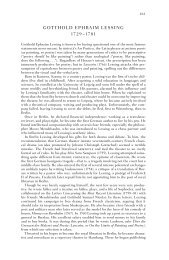
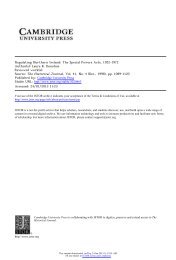


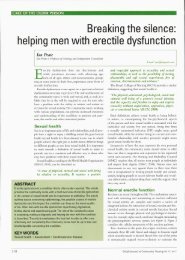
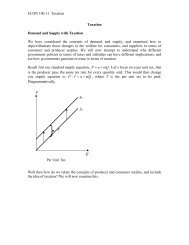
![The Rink - Cyril Dabydeen[1].pdf](https://img.yumpu.com/21946808/1/155x260/the-rink-cyril-dabydeen1pdf.jpg?quality=85)

